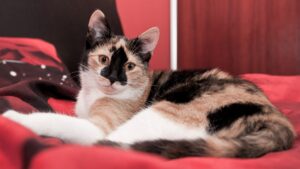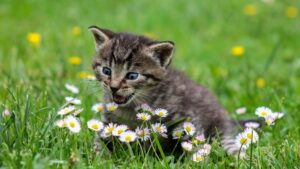If you have cats or if you are animal lover, you surely would have noticed the unique and magnificent fur coats of cats. Most people do not think much about it, but did you know that a cat’s fur coat, its colour and colour combinations, can reveal a lot about the animal?
These variations in colour and patterns are often caused by genetic mutations, which sometimes results in the most exotic looking cats. But their fur colours and patterns indicate something more than just what’s seen on the surface.
Table of Contents
Fur Coat Colours and Patterns
Every colour tells a story. Before you dive into the hidden meanings of each cat colour, familiarize yourself with common terminologies of the cat-world.
Here is a list of how cats are identified:
- Solid Colour Cats
- Bicolour Cats
- Calico Cats
- Tortoiseshell Cats
- Ginger Cats
- Tabby Cats
Solid Colour Cats

This cat’s fur consists of just one colour, which dominates the entire body. These cats can be found easily, as they make up the majority of the cats’ population.
The four most basic solid-colour cat furs are black, chocolate, cinnamon, and red (tabby). Any modification of these basic fur colours will lead to dilution. Some cats which possess solid colour fur coats are Bombay cats.
Solid colour cats are typically shy around new people, lazy in their comfort zones and calm during normal times.
Bicolour Cats

Bicoloured cats, also known as Piebald cats, have patches of white-coloured fur with any of the four other colours running across their entire body.
These cats also have different coat patterns like that of Tortoiseshell cats. Sometimes they tend to be solid colours as well, which depends upon the amount of white present.
Bicolour cats can be found in domestic cat breeds as well as others such as Maine Coon, Norwegian Forest Cat, Persian, and Turkish Van.
The characteristic traits of bicolour cats as stated are that they are very caring and affectionate towards their owners.
Calico Cats

Calico cats are tri-coloured cats and typically have orange and black patches covering their body on a white “base colour”.
They are predominantly females and can be found in all domestic cat breeds, generally. Statistically, only about 1 in 3,000 Calico cats is a male!
Calico cats are typically very aggressive towards other unknown cats and dogs when they are not domesticated. They are fearless when threatened. However, domestic Calicos can be very gentle, caring, and loving cats.
Tortoiseshell Cats

Just as the name suggests, the cat’s fur resembles that of tortoiseshell cats with distinctive multi-colour patches such as black, red, and orange fur. If the colours spread over the cat’s fur are in clear segments then they are patched fur, and if they are not in clear patches then it is categorized under bridled fur.
There are many breeds of tortoiseshell cats, and they are exclusively female cats.
The tortoiseshell cats are sometimes considered bossy and very active.
Ginger Cats

As the name suggests, the cats’ fur will be predominantly red/orange in colour, but it might have slight variations. The pigment decides the ginger shade of the cats’ fur, which might be shades of red or orange.
A majority of Ginger cats are males. They are very vocal and have a confident personality.
Female Ginger cats are typically calmer but just as friendly as male Gingers.
They have variations in fur patterns such as dark stripes, swirls, patches, dots, and patches.
These Ginger cats are addressed as Tabby cats, generally. However, not all Tabbies are Gingers.
Tabby Cats

All Ginger coloured cats are considered as Tabby cats like mentioned before, but not all tabby cats are ginger cats. Tabby cats are mostly domestic-breed cats and have an ‘M’ shaped crease on their forehead, which sets them apart from the ginger cats. Tabby cats can be found easily as these fur patterns and colours are common among other cat breeds. The tabby cats are also commonly known as tabbies.
These tabby cats are mostly friendly and affectionate by nature. But the ginger (red and orange) tabbies are pretty feisty.
Tabbies have many variations in their fur pattern owing to their genetics. Let’s examine them and their characteristics.
Mackerel Tabbies
The Mackerel Tabbies have stripes running across their bodies, and they are the most commonly found fur types in Tabby cats. The shape of an ‘M’ will be marked on its forehead by these stripes, differentiating them from ginger cats.
Classic Tabbies
These classic tabbies have thick swirls covering their entire body and have some distinctive marks on their bodies, as well. These are the second most common Tabby cats, right after Mackerel Tabbies.
Ticked Tabbies
They are mostly called Agouti tabbies because of the agouti hair on their body. Agouti refers to a fur type in which each strand of hair is alternate shades of dark and light. They do not have any other distinctive markings like swirls or stripes on their body.
Spotted Tabbies
These tabbies will have spots covering their entire fur coat, and these spots might either be large or small. These tabbies also possess the distinctive ‘M’ marketing on their forehead and are often confused with Mackerel tabbies because of the similarities with fur patterns.
Patched Tabbies
These patched tabbies refer to the tortoiseshell cats, but these have only orange and brown patches covering their entire body. It is common for Tortoiseshell cats to carry the same genetics as tabbies. These patches of colour can be majorly spotted around the legs and head area.
Conclusion
These are the various types of cat fur colours and patterns that contribute to their very distinguishing characteristics. These do not pertain to a particular cat breed, rather they are just the names for the colour of their fur coat. Hope that this blog made easier for you to differentiate between cats and decipher their characteristics accordingly based on their physical traits.







